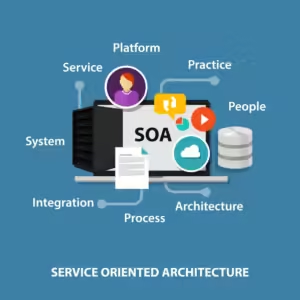In today’s rapidly evolving technological landscape, Service-Oriented Architecture (SOA) has emerged as a pivotal approach in modern IT consulting. This architecture pattern facilitates the seamless integration of various services, enhancing organizations’ agility, scalability, and efficiency. In this blog post, we will explore the critical role of SOA in IT consulting, detailing its benefits, applications, and future potential.
Grasping the Concept of Service-Oriented Architecture (SOA)
Before discussing SOA’s importance in IT consulting, it’s crucial to comprehend what Service-Oriented Architecture involves. SOA is an architectural methodology that facilitates the development of services—independent, functional units—that can be seamlessly integrated and reused across various applications and business operations.
Complete Example for Further Understanding:
Imagine you run an e-commerce platform that sells a wide variety of products. Your platform handles numerous functionalities, such as user authentication, payment processing, inventory management, and order tracking.
In a traditional monolithic architecture, all these functionalities would be tightly coupled within a single application, making it hard to update or reuse specific parts without affecting the entire system.
With Service-Oriented Architecture, each of these functionalities can be broken down into independent services:
- User Authentication Service: A self-contained service that handles user login, logout, and authentication.
- Payment Processing Service handles credit card processing, refunds, and payment gateways.
- Inventory Management Service: Manages stock levels, updates, and product listings.
- Order Tracking Service: Tracks the status of orders, shipment details, and delivery confirmations.
Integration and Reusability:
- Integration: Each service can communicate with others through standardized protocols (like HTTP or SOAP), allowing them to be integrated effortlessly. For instance, once a user places an order, the Order Tracking Service can call the Inventory Management Service to update stock levels and the Payment Processing Service to handle the transaction.
- Reusability: These services can be reused across different applications because they are self-contained. For example, the Payment Processing Service developed for your e-commerce platform can also be utilized by a mobile app or another business unit that requires payment functionality.
Benefits:
Using SOA, businesses can achieve:
- Flexibility: Easily update or replace individual services without disrupting the entire system.
- Scalability: Independently scale services based on demand.
- Improved Maintenance: Simplified debugging and maintenance due to separation of concerns.
- Reusability: Services can be reused across multiple applications, saving development time and resources.
SOA allows for a modular approach to system design, making complex IT environments more manageable and adaptable to changes.
Key Features of Service-Oriented Architecture
Reusability
One of SOA’s salient features is its emphasis on reusability. Services are designed to be reused across different applications, reducing redundancy and improving development efficiency.
Interoperability
SOA promotes interoperability by using standard communication protocols and data formats, ensuring diverse systems can communicate and work together seamlessly.
Scalability
With SOA, services can be scaled independently, allowing organizations to manage load and performance efficiently.
Loose Coupling
Services in an SOA environment are loosely coupled, meaning that changes in one service do not necessarily impact others. This decoupling simplifies maintenance and enhances flexibility.
The Role of SOA in Modern IT Consulting
Facilitates Digital Transformation
Digital transformation is a key priority for many organizations today, and SOA plays a crucial role in this process. By enabling the integration of various services, SOA allows businesses to transform their operations and adopt new technologies with minimal disruption.
Enhances Agility and Flexibility
In the fast-paced world of IT, agility is paramount. SOA enhances this agility by enabling the rapid deployment of services and facilitating continuous integration and delivery (CI/CD) processes. Consultants can quickly respond to client needs, implement changes, and introduce new functionalities without extensive overhaul.
Supports Multi-Cloud Strategy
As organizations increasingly adopt a multi-cloud strategy, SOA becomes instrumental in managing and integrating services across different cloud platforms. This architectural pattern ensures that services can interact and operate effectively in various cloud environments, optimizing resource utilization and performance.
Drives Cost Efficiency
Cost efficiency is a critical concern for businesses of all sizes. SOA helps reduce costs by promoting the reuse of existing services and minimizing the need to develop new functionalities from scratch. Additionally, the modular nature of SOA allows for incremental upgrades and changes, thereby reducing long-term maintenance costs.
Improves Customer Experience
In the era of customer-centric business models, improving customer experience is a top priority. SOA enables organizations to deliver personalized and seamless experiences by integrating diverse services that cater to customer needs. IT consultants leverage SOA to design and implement systems that provide cohesive and consistent user experiences across multiple touchpoints.
Real-World Applications of SOA
E-Commerce Platforms
E-commerce platforms extensively use SOA to manage various functionalities such as payment processing, order management, inventory tracking, and customer service. These platforms rely on many services working harmoniously to provide customers with a streamlined and efficient shopping experience.
Financial Services
The financial sector benefits significantly from SOA by integrating banking, insurance, and investment services. SOA helps create a unified customer interface and ensures seamless transactions across financial products and services.
Healthcare Systems
Healthcare systems utilize SOA to integrate patient records, appointment scheduling, billing systems, and diagnostic services. This integration fosters a collaborative environment where healthcare providers can access critical information in real time, enhancing patient care and operational efficiency.
Future of Service-Oriented Architecture in IT Consulting
Microservices and SOA
The advent of microservices architecture has further evolved the principles of SOA. Microservices take loosely coupled services to the next level by breaking down applications into smaller, independently deployable units. This evolution will likely continue, with SOA as the foundational framework for these advanced architectures.
Integration with Emerging Technologies
As emerging technologies like artificial intelligence (AI), the Internet of Things (IoT), and blockchain gain traction, SOA will play a crucial role in their integration. IT consultants will rely on SOA to create interconnected ecosystems where these technologies can operate synergistically.
Enhanced Security Measures
With IT environments’ increasing complexity, security remains a top concern. SOA will continue to evolve with robust security protocols and measures to ensure that services are efficient and secure from potential threats.
Conclusion
Service-oriented architecture (SOA) is indispensable in modern IT consulting, offering a framework that enhances agility, scalability, and interoperability. By facilitating digital transformation, supporting multi-cloud strategies, and driving cost efficiency, SOA empowers organizations to navigate the complexities of the technological landscape effectively. As we move forward, the principles of SOA will continue to underpin the development and integration of advanced architectures and emerging technologies, solidifying its role as a cornerstone of modern IT consulting.
By understanding and leveraging the benefits of Service-Oriented Architecture, IT consultants can deliver innovative solutions that drive business growth and success in an increasingly digital world.

